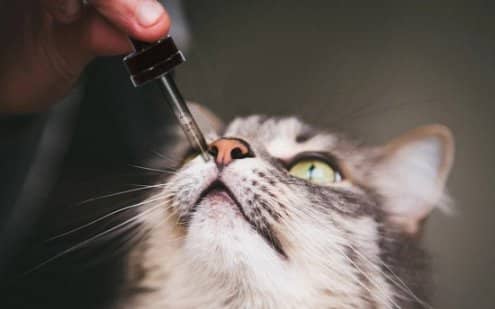Cats with diabetes often struggle with nerve issues, appetite changes, and poor nutrient absorption. Using vitamin b12 for cats may help support nerve function, gut health, and energy metabolism. This guide explains where B12 fits in diabetic care, forms to consider, and safety notes.
Key Takeaways
- Nerve support: B12 helps maintain myelin and peripheral nerve function.
- Gut link: Chronic GI disease can reduce cobalamin absorption.
- Form matters: Methylcobalamin is commonly used for neuropathic support.
- Monitor trends: Track weight, stools, gait, and labs over time.
Vitamin B12 for Cats in Diabetic Care
Diabetes in cats can coincide with peripheral neuropathy, weight loss, and intermittent diarrhea. Cobalamin (vitamin B12) supports cellular energy, red blood cell formation, and nerve myelin. When absorption is compromised by intestinal disease or pancreatic changes, serum B12 can fall. Correcting low cobalamin may help stabilize appetite, stools, and activity in some patients.
Veterinarians sometimes pair B12 supplementation with core diabetes therapy, diet, and glycemic monitoring. Always view B12 as supportive, not a replacement for insulin or diet changes. For insulin product context in feline care, see ProZinc Vial for protamine zinc insulin choices to discuss with your vet.
Recognizing Low B12: Clinical Signs and Testing
Owners commonly notice poor appetite, soft stools, or hind-limb weakness before diagnosis. Typical symptoms align with gastrointestinal malabsorption or neuropathy. When you suspect deficiency, ask your veterinarian about serum cobalamin testing and, if indicated, methylmalonic acid as a functional marker. Interpreting results within the cat’s overall condition is essential.
Classic descriptions include symptoms of low b12 in cats such as chronic diarrhea, weight loss, and lethargy. A stilted gait or plantigrade stance may indicate neuropathic change. For a focused overview of nerve complications in sugar-controlled cats, see Diabetic Neuropathy in Cats for pattern recognition and caregiver tips. Clinicians may repeat labs after several weeks of supplementation to confirm response.
Forms and Dosing Considerations
Two forms are commonly discussed: cyanocobalamin and methylcobalamin. Many clinicians prefer methylcobalamin for neuropathic support, while cyanocobalamin remains widely used and studied. Practical dosing routes include oral capsules, flavored liquids, and subcutaneous injections. Route selection depends on severity of deficiency, GI absorption, and owner comfort with home administration.
Discuss goals, route, and recheck plans with your veterinarian when considering methylcobalamin for cats dosage. If you and your vet choose injections, technique and needle selection matter. For safe at-home technique, your clinic may recommend syringes similar to BD Ultrafine II Syringes to ensure comfort and precision with small volumes.
Potential Benefits and Risks in Diabetic Cats
Potential benefits include improved energy, better stool quality, and support for nerve health, especially in cats with concurrent GI disease. Some owners report steadier appetite and easier weight maintenance after repletion. Response varies, and B12 alone does not correct poor glycemic control. Continued insulin therapy and diet remain central.
Most cats tolerate B12 well, but be aware of vitamin b12 for cats side effects, which are usually mild if they occur. Occasional injection-site discomfort or restlessness may be noted. Track any unusual signs, and inform your veterinarian if vomiting, diarrhea, or behavior changes appear after new supplements.
Special Situations: IBD, Pancreatitis, and Seniors
Chronic intestinal inflammation reduces cobalamin absorption, making deficiency more likely. In these cases, periodic parenteral B12 can bypass the gut and restore levels. For cats with pancreatic injury or chronic pancreatitis, exocrine function may be inconsistent, and low B12 can persist despite good diets. Regular monitoring helps tailor ongoing plans.
When GI and pancreatic disease overlap, clinicians may adjust schedule and route. This is why vitamin b12 for cats with pancreatitis is frequently discussed during diabetic workups. For a broader overview of pancreatic disease in diabetic patients, see Pancreatitis and Diabetes in Cats for cross-condition insights you can review with your vet.
Administration Tips and Monitoring
Build a simple tracking routine. Note appetite, stool consistency, weight, activity, and gait weekly. Recheck cobalamin after an initial course if your veterinarian advises. Many clinics coordinate lab rechecks with diabetes visits to reduce stress and duplicate appointments. Maintain a consistent feeding schedule to stabilize glycemic variability while assessing response.
Ask your veterinarian how often to give b12 to cats based on lab values and comorbidities. If injections are chosen, a small subcutaneous tent and calm handling reduce stress. For insulin and injection logistics in diabetic care, see Caninsulin Vial or ProZinc Vial for product context as you discuss comprehensive plans. Owners who administer insulin often adapt easily to B12 injections when advised by their clinic.
Dietary Sources and Product Selection
Commercial feline diets typically include adequate cobalamin for healthy absorbers. However, cats with chronic enteropathy may still show low serum levels. If your vet confirms deficiency, targeted supplementation offers more predictable correction than diet alone. Choose reputable veterinary or pharmacy-grade supplements when possible.
Discuss natural sources of b12 for cats, including animal proteins, as part of a balanced feeding plan. If you and your veterinarian are comparing formulations, review cyanocobalamin vs methylcobalamin for cats to align route and goals. For broader reading on diabetes themes, the Diabetes Articles category can help organize your research by topic and condition severity.
Related Conditions: Weight, Diarrhea, and Anemia
Weight trends matter in diabetes. Sudden or persistent loss deserves prompt assessment of glucose control, GI health, and other comorbidities. When deficiency is confirmed, vitamin b12 for cats weight loss may be part of a broader care plan that also optimizes insulin, diet, and environmental enrichment. Addressing each factor yields better stability.
Loose stools can stem from dietary changes, antibiotics, or chronic enteropathy. Clinicians may investigate parasites, inflammatory disease, or exocrine pancreatic insufficiency if diarrhea persists. For insulin delivery supplies that support consistent diabetes care, see BD Ultrafine II Syringes and the Diabetes Products category, which can help organize your kit at home.
Compare and Related Topics
Some diabetic patients receive metformin in specific contexts. Long-term human data associate metformin with reduced serum B12 in some users, which sparks owner questions. For background on this pharmacology and nutrient interaction, see Metformin and Vitamin B12 Absorption to understand mechanisms and monitoring suggestions discussed in clinical literature.
If your veterinarian suspects neuropathy, stable glycemic control remains the foundation of nerve recovery. For patterns, signs, and practical home observations, the Diabetic Neuropathy in Cats article provides checklists and examples. For multi-condition cases involving pancreatitis, Pancreatitis and Diabetes in Cats outlines shared signs and how your team may stage diagnostics.
Evidence and Safety Notes
Veterinary texts describe cobalamin’s role in enteropathies and neuropathies, with testing and parenteral protocols commonly used in practice. For a concise overview of deficiency mechanisms and clinical approach, review the Merck Veterinary Manual on cobalamin deficiency in small animals. General nutrient function and safety context can be found in the NIH’s Vitamin B12 fact sheet, which outlines metabolism and sources.
Diabetes management still hinges on insulin, diet, and monitoring. Veterinary organizations provide frameworks you can discuss locally. For an overview of clinical priorities, see AAHA’s diabetes management guidelines and align B12 use within that plan. Coordinate new supplements with your veterinarian to avoid confounding glucose patterns or duplicating therapies.
Recap
B12 supports nerve health and cellular metabolism in diabetic cats, especially when absorption is poor. Testing confirms deficiency and guides the route, frequency, and rechecks. Combine supplementation with stable insulin, diet, and consistent home tracking. When in doubt, review your notes and lab trends with your veterinary team.
Tip: Keep a simple one-page log for weight, stools, food intake, insulin doses, and any new supplements. It simplifies follow-up decisions.
Note: Category pages like Pet Health Articles can help you find related topics when multiple conditions overlap.
For insulin choices in feline diabetes, your veterinarian may reference Caninsulin Cartridges for practical dosing formats, or direct you to the broader Diabetes Products category when assembling supplies.
This content is for informational purposes only and is not a substitute for professional medical advice.
ProZinc Vial helps contextualize insulin options for diabetic cats. Diabetic Neuropathy in Cats offers pattern recognition for hind-limb weakness. Pancreatitis and Diabetes in Cats explains overlapping signs. Explore Diabetes Articles for structured reading. Visit BD Ultrafine II Syringes when discussing injection techniques with your clinic. Consider Caninsulin Vial and Caninsulin Cartridges for insulin background. See the Diabetes Products category for organizing at-home care.


